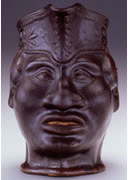About Face: Toussaint L’Ouverture and the African-American Image
Decorative Arts Gallery
Toussaint L’Ouverture was a former slave in Haiti who led the first successful slave revolt in the Americas in the 1790s. Since that time he has been a symbol of power and rebellion in the Atlantic world, hated and feared by opponents of racial equality, but also revered by the black community in Haiti and throughout the African diaspora. Among the many important commemorations of Toussaint is a group of portrait pitchers that are among the most striking of American ceramics. Made about 1840, probably for sale to abolitionists in the Boston area, these pitchers are boldly sculpted representations of an African-American male with a French tri-corner hat (one of Toussaint’s most recognizable attributes). To modern eyes the portrait—with its thick lips, wide, flat nose, a heavy brow and stylized curling hair—is exaggerated in a fashion that suggests racial stereotyping. Yet this representation, which today seems like caricature, may have been meant to lionize Toussaint, emphasizing his dangerous strength at a time when fighting slavery was still a desperate struggle.
The exhibition considers these extraordinary objects from several perspectives, situating them in four contexts that illuminate their meaning: historical representations of Toussaint (including works by the great 20th century African-American painter Jacob Lawrence); other abolitionist propaganda ceramics; derogatory racial images of the 19th century; and pots made by African-Americans as a way of shaping their own identities, including face jugs. This range of material—some of it beautiful, some of it disturbing—will demonstrate the continuing resonance of this Haitian leader and American audiences, bridging past and present perceptions.
- American, possibly Medford, Massachusetts, Pitcher, ca. 1840. Earthenware. Chipstone Foundation.

